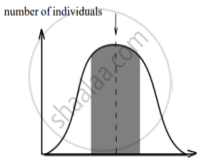Advertisements
Advertisements
प्रश्न
How does Hardy-Weinberg’s expression (p2+2pq+q2=1) explain that genetic equilibrium is maintained in a population? List any four factors that can disturb the genetic equilibrium.
उत्तर
The allele frequencies in a population are stable and are constant from generation to generation in the absence of gene flow, genetic drift, mutation, recombination, and natural selection. If a population is in a state of Hardy Weinberg equilibrium, the frequencies of alleles and genotypes or sets of alleles in that population will remain the same over generations. Evolution is a change in the allele frequencies in a population over time. Hence population in Hardy Weinberg is not evolving.
Suppose we have a large population of beetles, (infinitely large) and appear in two colours’ dark grey (black) and light grey, and their colour is determined by the ‘A’ gene. ‘AA’ and ‘Aa’ beetles are dark greys and ‘aa’ beetles are light grey. In a population let’s say that the ‘A’ allele has a frequency (p) of 0.3 and the ‘a’ allele has a frequency (q ) of 0.7. Then p + q = 1.
If a population is in Hardy Weinberg equilibrium the genotype frequencycan be estimated by Hardy Weinberg equation.
(p + q)2 = p2+ 2pq + q2
p2 = frequency of AA
2pq = frequency of Aa
q2 = frequency of aa
p = 0.3, q = 0.7 then,
p2 = (0.3)2 = 0.09 = 9 %AA
2pq = 2(0.3) (0.7) = 0.42 = 42 % Aa
q2 = (0.7)2 0.49 = 49 % aa
Hence the beetle population appears to be in Hardy - Weinberg equilibrium. When the beetles in Hardy - Weinberg equilibrium reproduce the allele and genotype frequency in the next generation would be: Let’s assume that the frequency of ‘A’ and ‘a’ allele in the pool of gametes that make the next generation would be the same, then there would be no variation in the progeny. The genotype frequencies of the parent appear in the next generation. (i.e. 9% AA, 42% Aa and 49% aa).
If we assume that the beetles mate randomly (selection of male gamete and female gamete in the pool of gametes), the probability of getting the offspring genotype depends on the genotype of the combining parental gametes.
संबंधित प्रश्न
Give the graphical representation of Hardy· Weinberg's principle in the form of Punnet Square.
With the help of an algebraic equation, how did Hardy-Weinberg explain that in a given population the frequency of occurrence of alleles of a gene is supposed to remain the same through generations?
According to the Hardy-Weinberg principle, the allele frequency of a population remains constant. How do you interpret the change of frequency of alleles in a population?
How does the Hardy-Wienberg equation explain genetic equilibrium?
A population will not exist in Hardly Weiberg equilibrium if ____________.
(p + q)2 = p2 + 2pq + q2 = 1 represents an equation used in ______.
Hardy - Weinberg equilibrium is known to be affected by gene - flow, genetic drift, mutation, genetic recombination and
Disturbance of Hardy - Weinberg equilibrium results in
For the MN-blood group system, the frequencies of M and N alleles are 0.7 and 0.3, respectively. The expected frequency of MN-blood group bearing organisms is likely to be ______.
Which type of selection explains industrial melanism observed in moth, Biston bitularia ______.
Among the five factors that are known to affect Hardy-Weinberg equilibrium, three factors are gene flow, genetic drift and genetic recombination. What are the other two factors?
Name the law that states that the sum of allelic frequencies in a population remains constant. What are the five factors that influence these values?
How is Hardy-Weinberg's expression “(p2 + 2pq + q2) = 1” derived?
The graphs below show three types of natural selection. The shaded areas marked with arrows show the individuals in the population who are not selected. The dotted vertical lines show the statistical means.
 |
 |
 |
| character Graph A |
character Graph B |
character Graph C |
- What names are given to the types of selection shown in graphs A, B and C?
- After the selection has operated for several generations in the above populations indicated as, Graph A, B and C, graphically illustrate the probable results.
State Hardy Weinberg's principle.
A population of 200 fruit flies is in Hardy Weinberg equilibrium. The frequency of the allele (a) 0.4. Calculate the following:
The number of homozygous dominant fruit flies.
A population of 200 fruit flies is in Hardy Weinberg equilibrium. The frequency of the allele (a) 0.4. Calculate the following:
The number of homozygous recessive fruit flies.
